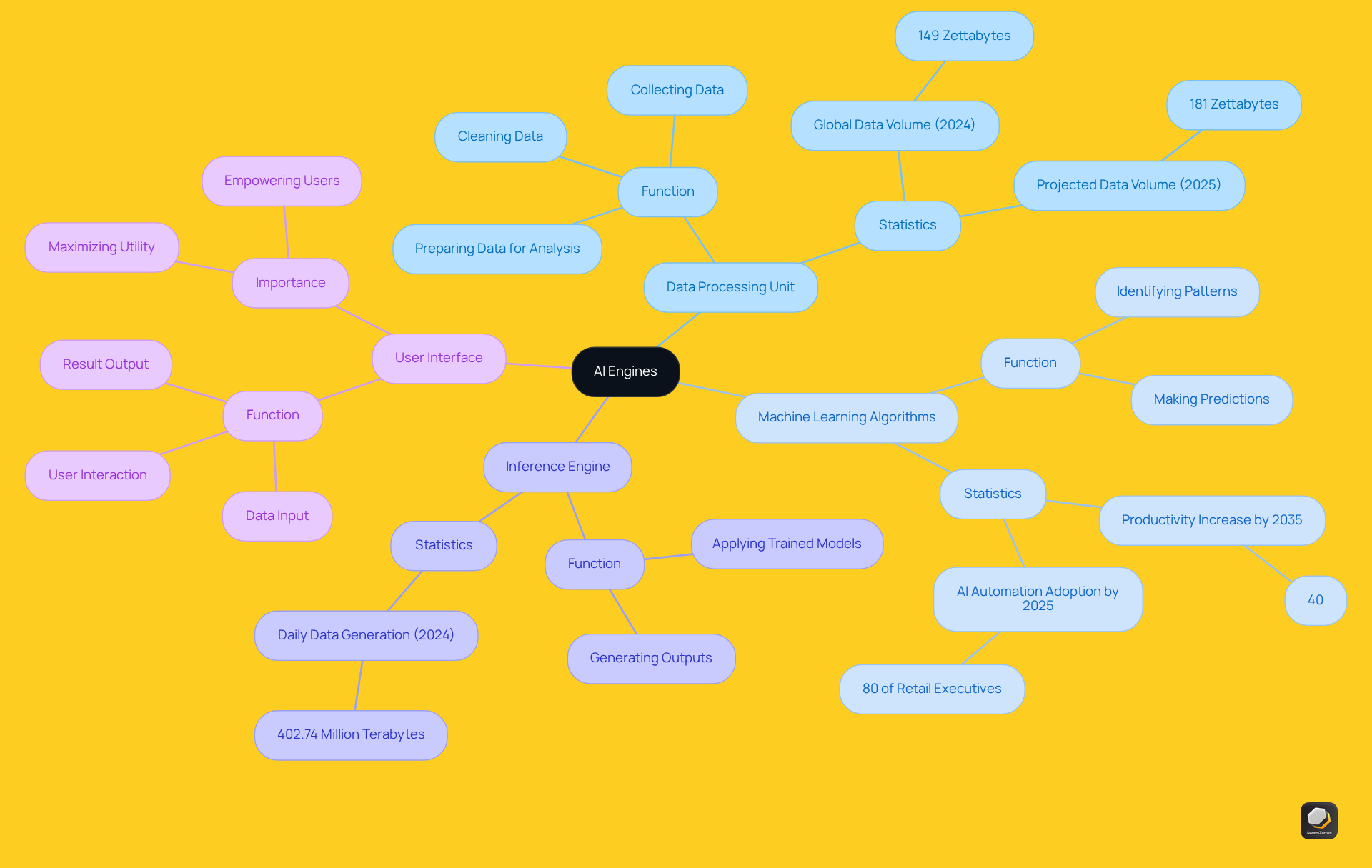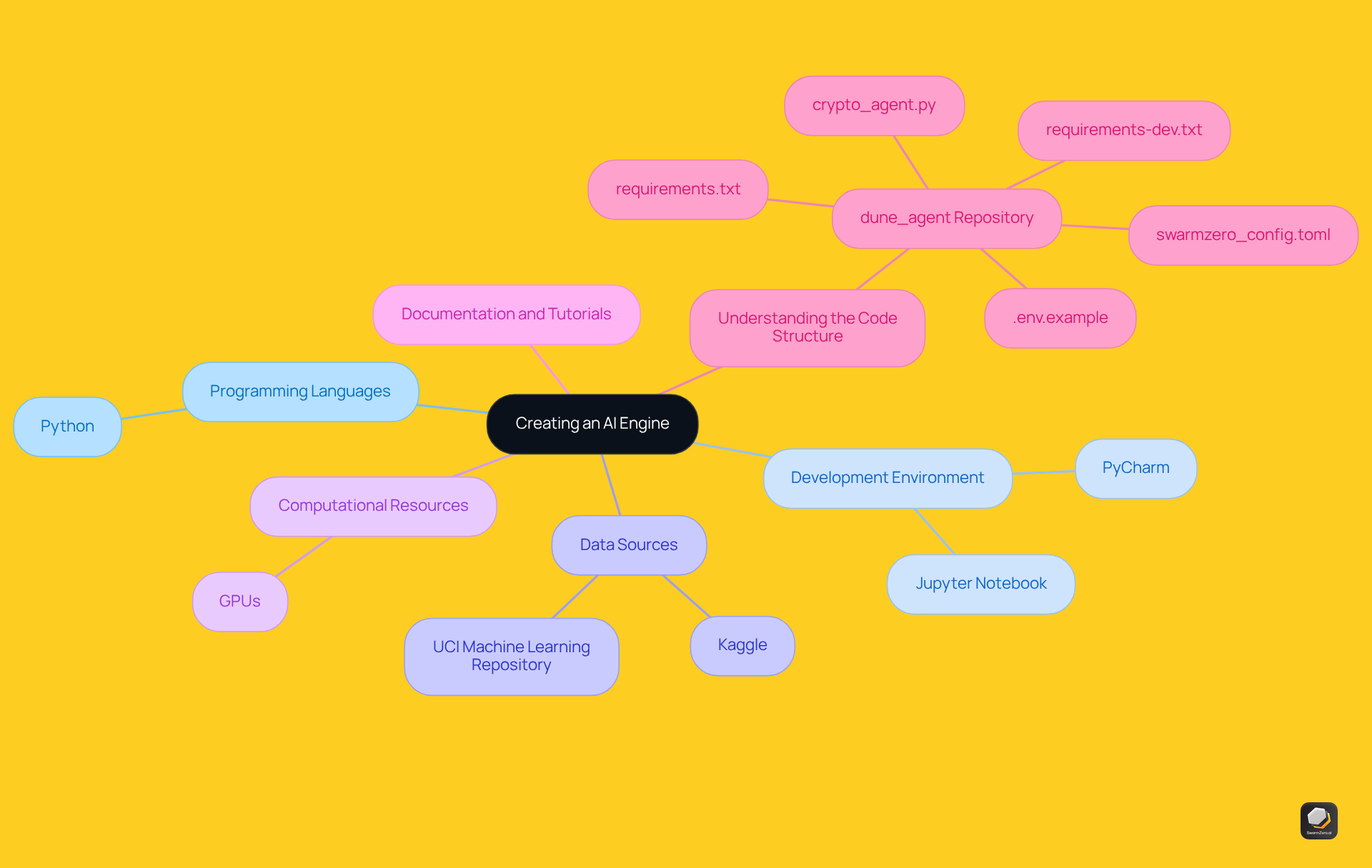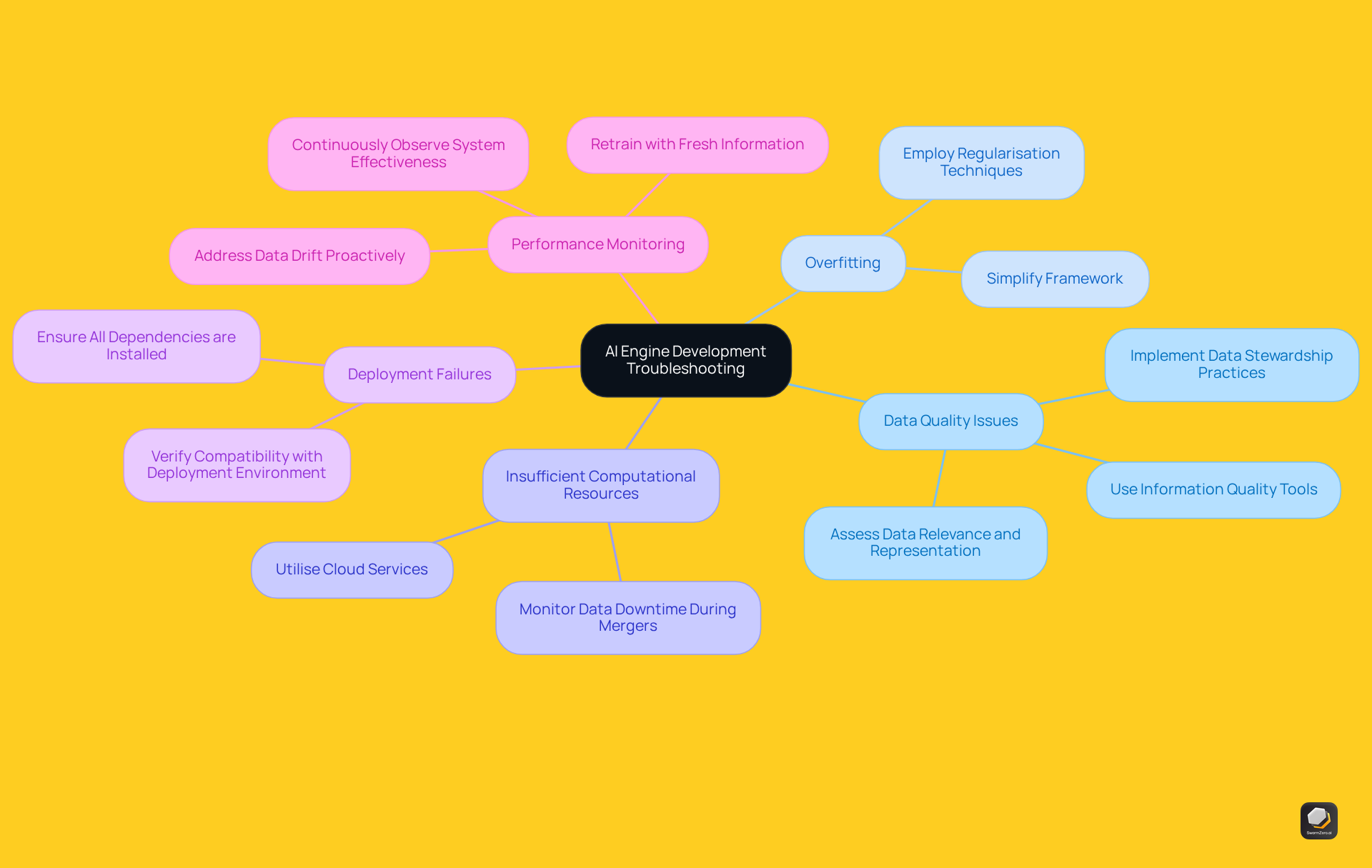How to Create an AI Engine: Essential Steps for Success
Discover how to create an AI engine with essential steps and key components for success.

Key Highlights:
- AI engines consist of a Data Processing Unit, Machine Learning Algorithms, an Inference Engine, and a User Interface, all crucial for effective operation.
- The global information volume is projected to rise from 149 zettabytes in 2024 to 181 zettabytes by 2025, highlighting the need for robust data processing.
- Machine learning algorithms are expected to boost employee productivity by 40% by 2035, with widespread adoption anticipated in retail by 2025.
- Building an AI engine requires tools such as Python, IDEs like PyCharm, relevant datasets, and sufficient computational resources like GPUs.
- The step-by-step process for creating an AI engine includes defining the problem, collecting and preparing data, choosing the right approach, training, evaluating, deploying, and monitoring the system.
- Common issues in AI development include data quality problems, overfitting, insufficient computational resources, deployment failures, and the need for performance monitoring.
- Addressing data quality is crucial, as poor quality can lead to significant financial losses, averaging $15 million per year for organisations.
- Overfitting can be mitigated through simplification of models and regularisation techniques.
Introduction
Creating an AI engine is no small feat, particularly in a world where data is expanding at an unprecedented rate, projected to reach 181 zettabytes by 2025. As organisations increasingly rely on AI to extract insights from vast datasets, it becomes imperative to understand the fundamental components and processes involved in developing an effective AI engine. This guide outlines the essential steps for successful AI engine development and addresses common pitfalls that can impede progress.
What challenges may arise during this intricate journey? How can they be navigated effectively to ensure a robust and efficient AI solution?
Understand the Basics of AI Engines
AI engines represent advanced systems designed to manage information, execute algorithms, and make intelligent decisions. They comprise several key components that work in unison to deliver effective outcomes:
- Data Processing Unit: This unit is essential for collecting, cleaning, and preparing data for analysis. As of 2024, the global information volume is at 149 zettabytes, projected to reach 181 zettabytes by 2025. This underscores the immense scale of content that AI systems must manage. Effective information processing is vital for ensuring that AI engines operate efficiently and accurately.
- Machine Learning Algorithms: These algorithms learn from processed information to identify patterns and make predictions. AI technologies are anticipated to enhance employee productivity by 40% by 2035, with 80% of retail executives expecting AI automation adoption by the end of 2025. The significance of these algorithms in driving business success is increasingly evident.
- Inference Engine: This component applies the trained model to new information, generating outputs that inform decision-making. Real-time information processing is crucial for dynamic decision-making, especially considering that approximately 402.74 million terabytes of information are produced daily in 2024. This capability enables organisations to respond swiftly to evolving conditions.
- User Interface: This allows users to interact with the AI system, input data, and receive results. A user-friendly interface is critical for maximising the utility of AI systems, empowering users to leverage AI capabilities effectively.
Understanding these components is essential for learning how to create an AI engine, as they form the backbone of any AI engine you will develop. Experts emphasise that incorporating sophisticated information processing techniques is vital for the success of AI applications across various sectors. For instance, AI algorithms can increase leads by up to 50%, illustrating the tangible benefits of efficient information handling in marketing and sales.
By 2025, the importance of processing units in AI systems will only grow, as organisations increasingly rely on AI to manage vast datasets and derive actionable insights. Companies that prioritise robust data processing capabilities will position themselves at the forefront of the AI adoption curve, ensuring they can fully harness the transformative potential of this technology.

Gather Required Tools and Resources
To create an AI engine, you will need several essential tools and resources:
- Programming Languages: Python is highly recommended due to its extensive libraries for AI development, including TensorFlow and PyTorch.
- Development Environment: Set up an IDE (Integrated Development Environment) such as PyCharm or Jupyter Notebook for efficient coding.
- Data Sources: Identify and gather datasets relevant to the problem you aim to solve. Public datasets can be sourced from platforms like Kaggle or the UCI Machine Learning Repository.
- Computational Resources: Ensure access to sufficient computational power, such as GPUs, to facilitate efficient model training.
- Documentation and Tutorials: Leverage online resources, tutorials, and documentation to navigate the development process effectively.
- Understanding the Code Structure: Familiarise yourself with the dune_agent repository, which includes key files such as
swarmzero_config.tomlfor configuration settings,crypto_agent.pyfor the main logic, andrequirements.txtfor dependencies. Additionally, review the.env.examplefile for environment variables andrequirements-dev.txtfor development dependencies. This knowledge is crucial for learning how to create an AI engine that effectively customises SwarmZero AI agents.

Build Your AI Engine: Step-by-Step Process
To successfully build your AI engine, follow these essential steps:
-
Define the Problem: Clearly articulate the specific problem your AI engine aims to solve. This foundational step is crucial as it directs the entire development process and ensures that the AI solution aligns with business objectives. For instance, a retail company might define the problem as needing to enhance customer engagement through personalised marketing.
-
Collect and Prepare Data: Gather relevant datasets that will inform your AI model. Information preparation is essential; it entails cleaning the information to eliminate inaccuracies, normalising it to guarantee consistency, and dividing it into training and testing sets. Organisations ought to consistently assess their information for quality and relevance, as high-quality datasets greatly enhance AI effectiveness. Investing in strong information gathering and preprocessing techniques can further improve the performance of your AI agents. Common challenges in this step include data quality, availability, and integration issues.
-
Choose the Right Approach: Select a machine learning approach that best fits the nature of your problem. For instance, if your aim is to categorise customer feedback, a classification system would be suitable. Grasping the strengths and limitations of different frameworks is crucial for effective problem-solving.
-
Train the System: Utilise your training information to teach the system. During this stage, carefully track effectiveness indicators to guarantee the system learns efficiently. Methods like cross-validation can assist in avoiding overfitting, ensuring that the system adapts effectively to new information.
-
Evaluate the System: After training, analyse the system's effectiveness using your test set. This evaluation phase is critical for identifying areas for improvement. Modify parameters as needed to improve precision and ensure the system meets the established problem's requirements.
-
Deploy the System: Once satisfied with its results, implement it in a setting where it can handle new information and provide outputs. Ensure that the deployment environment is suitable for the system's requirements and can manage the anticipated workload.
-
Monitor and Maintain: Continuous monitoring of the AI engine's performance is essential. Frequent updates and upkeep will assist the system in adjusting to new information and evolving business requirements, guaranteeing its long-term efficiency.
Real-world examples illustrate the importance of these steps. For instance, a financial institution effectively identified its issue as the requirement for real-time fraud detection, resulting in the creation of an AI system that examines transaction patterns to highlight irregularities. Practitioners emphasise that thorough data preparation techniques, such as normalisation and error removal, are foundational to achieving high model accuracy. High-quality datasets are crucial for effective AI tasks such as image recognition and natural language processing. By adhering to these steps and best practises, organisations can effectively understand how to create an AI engine that enhances operational efficiency and innovation.

Troubleshoot Common Issues in AI Engine Development
When learning how to create an AI engine, you may encounter several common issues. Here are some troubleshooting tips to help you navigate these challenges:
-
Data Quality Issues: If your model is underperforming, the first step is to assess the quality of your data. Ensure that it is clean, relevant, and representative of the problem you are trying to solve. Subpar information quality can lead to considerable errors in predictions. Research indicates that organisations may face average yearly expenses of $15 million due to information quality problems. Implementing dedicated information quality tools and information stewardship practices is essential for maintaining high standards.
-
Overfitting: A frequent mistake in machine learning is overfitting, where the system performs exceptionally well on training sets but poorly on unfamiliar test sets. To combat this, consider simplifying your framework or employing techniques such as regularisation. Notably, a report emphasises that at least 30% of generative AI projects will be discarded after proof of concept due to inadequate information quality and overfitting challenges, underscoring the critical importance of addressing these issues.
-
Insufficient Computational Resources: If you find that training is slow or fails altogether, it may be due to inadequate computational resources. Utilising cloud services can provide the additional capability required to effectively train your systems. Be aware that organisations may experience data downtime during events like mergers and acquisitions, which can impact the availability of computational resources.
-
Deployment Failures: Should your system fail to deploy, verify its compatibility with the deployment environment and ensure that all necessary dependencies are correctly installed. This step is crucial for a smooth transition from development to production.
-
Performance Monitoring: After deployment, it is essential to continuously observe your system's effectiveness. If you notice a decrease in precision over time, retraining the system with fresh information can help preserve its efficiency. Routine evaluations are vital, as information drift can significantly affect the dependability of the system. Proactively addressing data drift is essential for maintaining model effectiveness.
By proactively addressing these common issues, you can improve your understanding of how to create an AI engine that performs reliably and meets the demands of your organisation.

Conclusion
Creating an AI engine is a multifaceted journey that demands a profound understanding of its foundational components and a structured approach to development. By grasping essential elements such as:
- Data processing units
- Machine learning algorithms
- Inference engines
- User interfaces
developers can establish the groundwork for effective AI solutions that align with business needs.
This article outlines a comprehensive step-by-step process that includes:
- Defining the problem
- Gathering and preparing data
- Selecting the appropriate machine learning approach
- Training and evaluating the system
- Deploying it
- Maintaining its performance
Each stage is crucial, ensuring that the AI engine not only functions as intended but also adapts to evolving requirements and data inputs. Common challenges, such as data quality issues, overfitting, and deployment failures, are addressed with practical troubleshooting tips, reinforcing the importance of diligence throughout the development process.
Ultimately, the significance of building a robust AI engine cannot be overstated. As organisations increasingly rely on intelligent systems to drive efficiency and innovation, understanding how to create an AI engine becomes imperative. By following best practises and proactively addressing potential issues, developers can harness the full potential of AI technology, paving the way for transformative advancements across various sectors. Embracing this knowledge equips both individuals and businesses to thrive in an ever-evolving technological landscape.
Frequently Asked Questions
What are AI engines?
AI engines are advanced systems designed to manage information, execute algorithms, and make intelligent decisions. They consist of several key components that work together to deliver effective outcomes.
What is the role of the Data Processing Unit in AI engines?
The Data Processing Unit is essential for collecting, cleaning, and preparing data for analysis. It ensures that AI engines operate efficiently and accurately, especially given the immense volume of global information, projected to reach 181 zettabytes by 2025.
How do Machine Learning Algorithms contribute to AI engines?
Machine Learning Algorithms learn from processed information to identify patterns and make predictions. They are expected to enhance employee productivity significantly and are increasingly recognised as crucial for driving business success.
What is the function of the Inference Engine in an AI system?
The Inference Engine applies the trained model to new information, generating outputs that inform decision-making. Real-time information processing is vital for dynamic decision-making, enabling organisations to respond quickly to changing conditions.
Why is a User Interface important in AI engines?
The User Interface allows users to interact with the AI system, input data, and receive results. A user-friendly interface is critical for maximising the utility of AI systems and empowering users to effectively leverage AI capabilities.
What are the benefits of efficient information handling in AI applications?
Efficient information handling can lead to tangible benefits, such as increasing leads by up to 50% in marketing and sales. This highlights the importance of sophisticated information processing techniques in various sectors.
How is the importance of processing units in AI systems expected to change by 2025?
By 2025, the importance of processing units will grow as organisations increasingly rely on AI to manage vast datasets and derive actionable insights. Companies that prioritise robust data processing capabilities will be better positioned to harness the transformative potential of AI technology.
List of Sources
- Understand the Basics of AI Engines
- Data Statistics (2025) - How much data is there in the world? (https://rivery.io/blog/big-data-statistics-how-much-data-is-there-in-the-world)
- AI revolutionizing industries worldwide: A comprehensive overview of its diverse applications (https://sciencedirect.com/science/article/pii/S2773207X24001386)
- 50 NEW Artificial Intelligence Statistics (June 2025) (https://explodingtopics.com/blog/ai-statistics)
- AI Insights: 20 statistics transforming business in 2025 (https://blog.superhuman.com/ai-insights)
- Gather Required Tools and Resources
- Top AI Programming Languages You Should Know in 2025 (https://radixweb.com/blog/ai-programming-languages)
- Microsoft Build 2025: The age of AI agents and building the open agentic web - The Official Microsoft Blog (https://blogs.microsoft.com/blog/2025/05/19/microsoft-build-2025-the-age-of-ai-agents-and-building-the-open-agentic-web)
- Why Developers Are Choosing Claude Code (https://spectrum.ieee.org/best-ai-coding-tools)
- Microsoft Build 2025 Book of News (https://news.microsoft.com/build-2025-book-of-news)
- Build Your AI Engine: Step-by-Step Process
- AI Training Dataset Statistics and Facts (2025) (https://scoop.market.us/ai-training-dataset-statistics)
- What Is Artificial Intelligence (AI)? | IBM (https://ibm.com/think/topics/artificial-intelligence)
- Step-by-Step Guide on Building AI Agents for Beginners (https://codewave.com/insights/build-ai-agents-beginners-guide)
- Denmark to build one of the world’s most powerful AI supercomputers, accelerating solutions to societal challenges - Novo Nordisk Fonden (https://novonordiskfonden.dk/en/news/denmark-to-build-one-of-the-worlds-most-powerful-ai-supercomputers-accelerating-solutions-to-societal-challenges)
- Machine learning - Wikipedia (https://en.wikipedia.org/wiki/Machine_learning)
- Troubleshoot Common Issues in AI Engine Development
- Why Data Quality is the Secret Ingredient to AI Success - insideAI News (https://insideainews.com/2024/11/01/why-data-quality-is-the-secret-ingredient-to-ai-success)
- The 7 most common data quality issues (https://collibra.com/blog/the-7-most-common-data-quality-issues)
- Measuring the importance of data quality to causal AI success (https://dynatrace.com/news/blog/the-importance-of-data-quality-to-causal-ai)
- Four data and model quality challenges tied to generative AI (https://deloitte.com/us/en/insights/topics/digital-transformation/data-integrity-in-ai-engineering.html)
- Gartner Predicts 30% of Generative AI Projects Will Be Abandoned After Proof of Concept By End of 2025 (https://gartner.com/en/newsroom/press-releases/2024-07-29-gartner-predicts-30-percent-of-generative-ai-projects-will-be-abandoned-after-proof-of-concept-by-end-of-2025)




